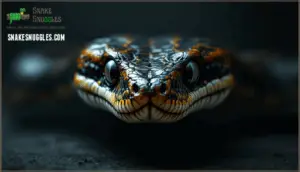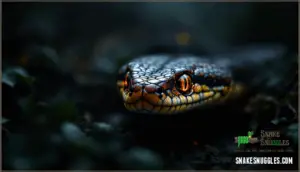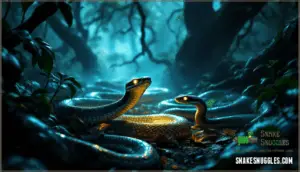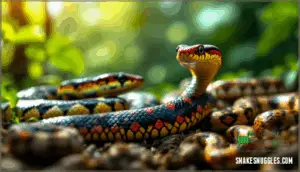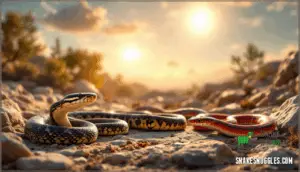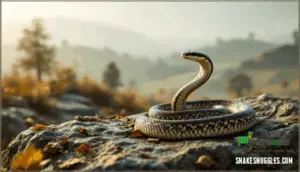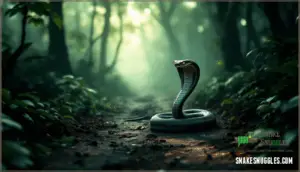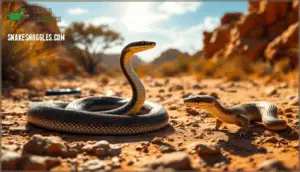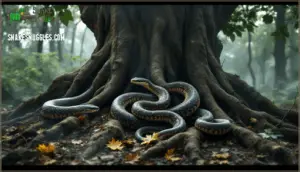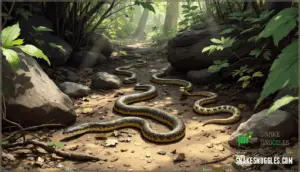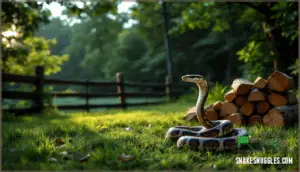This site is supported by our readers. We may earn a commission, at no cost to you, if you purchase through links.
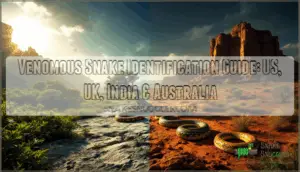
In Australia, the inland taipan packs the world’s most toxic venom, while Britain hosts just one venomous species that rarely causes serious harm. Understanding these regional differences and visual markers isn’t just academic curiosity; it’s practical knowledge that could prevent a medical emergency or ease unnecessary fear during your next hike.
Table Of Contents
- Key Takeaways
- Venomous Snake Identification Basics
- Venomous Snakes in The U.S
- Venomous Snakes in The UK
- Venomous Snakes in India
- Venomous Snakes in Australia
- Venomous Snakes in Virginia
- Non-Venomous Snakes in Virginia
- Iconic Virginia Snake Species
- Coexisting With Virginia Snakes
- Frequently Asked Questions (FAQs)
- How do you identify a venomous snake in Virginia?
- How do you identify a poisonous snake?
- How do you know if a snake is venomous?
- How do you identify a venomous snake in Florida?
- What does a non venomous snake look like?
- Are snakes poisonous?
- What is the easiest way to identify a venomous snake?
- How do I identify a snake I found?
- How can you tell the difference between a poisonous and nonpoisonous snake?
- How do you identify venomous snakes?
- Conclusion
Key Takeaways
- Venomous snakes share reliable physical markers—triangular heads housing venom glands, elliptical pupils, heat-sensing pits between eyes and nostrils, and distinctive body patterns—that help you distinguish dangerous species from harmless ones, though you should never rely on a single feature for identification.
- Regional knowledge matters more than universal rules because venomous species vary dramatically by location: the U.S. hosts primarily pit vipers like rattlesnakes and copperheads, the UK has only the mild-mannered adder, India’s "Big Four" cause tens of thousands of deaths annually, and Australia claims the world’s most toxic snakes including the inland taipan.
- Most venomous snakes prefer retreat over confrontation and only strike when cornered, surprised, or stepped on, making your behavior—staying calm, backing away slowly, maintaining at least six feet of distance, and avoiding sudden movements—more critical to safety than perfect identification skills.
- Immediate medical attention after any suspected venomous bite can mean the difference between survival and tragedy, so call 911 right away, keep the victim still to slow venom spread, photograph the snake from a safe distance if possible, and contact Poison Control while waiting for emergency responders.
Venomous Snake Identification Basics
Knowing whether a snake is venomous can be the difference between a calm encounter and a medical emergency. You’ll need to recognize key physical traits that separate dangerous species from harmless ones.
Let’s look at the four main identification features that help you make that call quickly and safely.
Head Shape and Features
The triangular head—nature’s most reliable warning sign—sets venomous snakes apart from their harmless cousins. Pit organs and heat sensing aren’t the only clues. When identifying venomous snakes by appearance, focus on these triangular head features:
- Broad, wedge-shaped skull behind the eyes
- Dramatic neck constriction creating clear separation
- Heavy, muscular jaw structure
- Pronounced bulging from venom glands
- Angular facial features versus rounded contours
These scalation patterns and snake identification techniques help you recognize pit vipers like rattlesnakes. However, head shape isn’t foolproof—some harmless species mimic these characteristics. Always exercise caution during any snake encounter.
Pit Organs and Heat-sensing Abilities
Between the triangular head and those distinctive scales lies another extraordinary adaptation—pit organs that function as biological infrared sensors, letting venomous pit vipers hunt warm-blooded prey in complete darkness.
These specialized heat-sensing structures create thermal imaging capabilities that surpass ordinary snake vision. Located between the nostril and eye, each pit organ detects temperature changes as subtle as 0.003°C, making infrared detection essential for snake behavior and habitat success in venomous snake identification guide research.
Pupil Shape and Light Sensitivity
While pit organs offer reliable identification clues, many people instinctively check a snake’s pupils first—but this method can mislead you more often than you’d expect. Eye structure varies considerably among snake species, making pupil response an unreliable marker for venomous snake identification guide purposes. Light reflex dramatically alters what you see:
- Elliptical pupils appear round in bright conditions
- Iris color shifts with lighting angles
- Visual acuity differences don’t correlate with venom
- Some venomous snakes possess round pupils
- Pupil shape overlaps between venomous and harmless species
Reptile biology reveals that relying solely on snake identification through pupils creates dangerous misidentifications.
Coloration and Patterns
Color patterns don’t lie—they’re your fastest field marker when identifying whether a snake poses a real threat. Venomous snakes display distinctive banding styles and scale texture variations that immediately separate them from harmless species. Coral snakes flash their iconic red-yellow-black warning rings, while rattlesnakes exhibit bold diamond patterns along their backs. Understanding snake coloration helps you make split-second safety decisions in the field.
Watch for these critical pattern recognition markers:
- Bright warning colors: Reds, yellows, and blacks signal potential danger in venomous snake species
- Camouflage techniques: Earth tones with irregular blotches help copperheads disappear into leaf litter
- Contrasting bands: Uniform rings or saddles often indicate venom-bearing species
- Belly coloration: Dramatic shifts between dorsal and ventral surfaces reveal identity clues
Master these snake patterns, and you’ll navigate any habitat with confidence.
Venomous Snakes in The U.S
The United States is home to around 20 venomous snake species, with nearly all of them classified as pit vipers.
Understanding which species you might encounter can help you stay safe when you’re hiking, camping, or working outdoors. Let’s look at the main venomous snakes you’ll find across the country.
General Characteristics
In North America, identifying venomous snakes starts with recognizing shared physical traits that distinguish them from harmless species. Most venomous snakes possess triangular or diamond-shaped heads—enlarged by venom glands—though coral snakes break this rule with their rounded heads. Understanding these characteristics of venomous snakes is essential for venomous snake identification and safety.
Key features to look for include:
- Heat sensing pits positioned between the eye and nostril in pit vipers, detecting temperature differences as small as 0.003°C
- Elliptical pupils resembling a cat’s eye, common in rattlesnakes, copperheads, and cottonmouths
- Snake body types with distinct patterns and coloration serving as camouflage or warning signals
These venomous snakes display advanced venom delivery through hollow fangs. Their venom potency varies by species, but all demand respect. Snake behavior also offers clues—many adopt defensive postures when threatened. Remember, this snake identification guide helps you stay safe, but when you’re uncertain about any snake’s identity, always keep your distance. To ensure safety, it’s vital to learn about venomous snake identification techniques and guidelines.
Cottonmouths (Water Moccasins)
Cottonmouths patrol the slow-moving waters of the Southeast like coiled sentinels, their dark bodies blending seamlessly with muddy banks and cypress roots. These pit vipers, ranging from olive-brown to nearly black, inhabit swamps, streams, and lakes from Virginia down through Florida and west to Texas. Their Habitat Preferences include any freshwater environment where fish, frogs, and small mammals thrive.
When threatened, a Cottonmouth reveals its namesake feature—a striking white mouth gape that acts as nature’s warning label. This Aggressive Behavior is defensive posturing, not unprovoked hostility. The snake’s hemotoxic Venom Composition destroys tissue and disrupts blood clotting, making prompt medical attention critical after Snake Bites.
Venomous Snake Identification becomes straightforward once you recognize their Water Adaptations: thick bodies, triangular heads with heat-sensing pits, and that characteristic defensive display. For your safety, maintain distance and let these exceptional predators patrol their domain undisturbed.
Rattlesnakes
The unmistakable buzz of a rattlesnake’s tail acts as nature’s alarm system, warning you to back away before fangs deploy venom that can drop a deer. These pit vipers dominate diverse snake habitats, from deserts to mountain forests, using heat-sensing pits between their eyes and nostrils to hunt warm-blooded prey in complete darkness.
Venomous snake identification gets easier when you recognize their key features:
- Rattle sounds progress from subtle buzzing in juveniles to aggressive warnings in adults
- Tail patterns feature distinctive diamond or banded markings that aid camouflage
- Triangular heads house massive venom glands behind cat-like elliptical pupils
Their hunting behavior involves patient ambush tactics, striking with lightning speed when prey ventures close. Venom effects include tissue destruction and blood clotting disruption, making immediate medical care essential after bites.
Among rattlesnakes, species like the Western Diamondback showcase why proper snake identification matters—their potent venom demands your respect and distance.
Copperheads
When you spot a snake with a copper-red head and hourglass bands hugging a forest floor, you’re likely staring at one of North America’s stealthiest ambush predators. Copperheads rely on camouflage rather than aggression, freezing motionless among leaf litter in their woodland habitat preferences. Their venom composition causes tissue damage but rarely proves fatal, making snakebite symptoms painful yet survivable with proper care.
- Triangular heads signal venomous snake identification
- Regional distribution spans eastern U.S. forests
- Copperhead behavior favors patient, motionless hunting
Coral Snakes
Unlike copperheads that blend into leaf litter, coral snakes advertise their deadliness with bands so bright you’d think nature plastered a warning label across their bodies. Red, yellow, and black rings circle these southeastern dwellers, whose neurotoxic venom potency makes them one of North America’s most dangerous snakes despite their shy snake behavior. You’ll rarely encounter them in their woodland coral snake habitat, but when you do, remember this rule for venomous snake identification:
Coral snakes advertise their deadliness with red, yellow, and black bands—nature’s warning label for one of North America’s most neurotoxic vipers
| Feature | Coral Snake | Scarlet Kingsnake |
|---|---|---|
| Color Patterns | Red-Yellow-Black | Red-Black-Yellow |
| Geographic Range | Southeastern U.S. | Similar overlap |
| Venom Potency | Highly neurotoxic | Harmless mimic |
Red touches yellow—you’re looking at danger.
Venomous Snakes in The UK
The UK is home to just one venomous snake species, making identification straightforward compared to other regions. The adder, also called the common viper, is the only native venomous snake you’ll encounter across Britain.
Here’s what you need to know about this distinctive species.
Adder (Common Viper)
You’ll find adders scattered across Britain, from coastal dunes to mountain moorlands. Though their bites rarely threaten human life when proper medical care is available, these pit vipers prefer dry habitats with plenty of cover. Their venom composition causes localized swelling rather than life-threatening symptoms.
Here’s what matters for snake identification:
- Bite symptoms usually remain mild with medical treatment
- Conservation status remains vulnerable across their geographic range
- Habitat preferences include heathlands and sunny woodland edges
- Venomous snakes like adders control rodent populations naturally
- Snake species identification prevents unnecessary panic during encounters
Adder Distribution and Bite Severity
Across Britain, adders thrive in heathlands, moorlands, and sunny woodland edges from southern England to Scotland—but they’re absent from Ireland and several Scottish islands. Most of the roughly 100 annual UK bites happen between April and July, usually when you disturb a basking snake.
Swelling appears within two hours, sometimes with vomiting or discoloration. Yet hospital records show only 14 deaths in the last century, making adder bites far less deadly than bee stings. Children often recover faster than adults, though severe cases warrant Zagreb antivenom within two hours for best results.
Adders are a key part of the wildlife conservation efforts in the UK.
Adder Behavior and Identification
If you’re trekking through British countryside and catch a glimpse of movement in the underbrush, knowing what sets an adder apart from harmless grass snakes could save you from an uncomfortable afternoon.
Look for three telltale signs:
- Bold V-shaped marking on the head, dark against brown or grey scales
- Zigzag dorsal stripe running the length of the body—perfect adder camouflage in heathland
- Vertical slit pupils, unlike the round eyes of non-venomous snake species
These pit vipers favor sunny moorlands and woodland edges, where their venom toxicity evolved to subdue small mammals. During spring mating rituals, males engage in "dancing" combat. Though bites cause swelling and pain, fatalities remain extremely rare with prompt treatment.
Venomous Snakes in India
India is home to some of the world’s deadliest venomous snakes, with thousands of snakebite incidents occurring each year. The country’s "Big Four" species account for the vast majority of serious envenomings and deaths.
Here’s what you need to know about each of these dangerous snakes.
The Big Four
India’s "Big Four"—Russell’s viper, common krait, Indian cobra, and saw-scaled viper—cause roughly 90% of the country’s snakebite incidents, claiming approximately 46,000 lives annually. These dangerous snakes deliver neurotoxic and hemotoxic venoms that can kill without prompt treatment.
Climate impact is shifting Big Four habitats northward, expanding their range into previously unaffected districts.
Snakebite prevention starts with recognizing these Indian species and understanding their preferred territories. If you’re in Big Four habitats, stay vigilant and seek immediate medical care after any bite.
Common Cobra
The Indian cobra’s raised hood isn’t just a warning—it’s one of nature’s most recognizable threat displays, signaling that you’ve entered the domain of a snake whose venom can shut down your nervous system in hours. Found across India’s diverse geographic range, this species thrives in agricultural zones and human settlements, where habitat loss increasingly forces encounters. Understanding snake behavior helps you stay safe—cobras usually retreat unless cornered or provoked.
Snake identification markers include:
- Distinctive spectacle marking on the hood’s dorsal surface
- Glossy scales ranging from tan to dark brown or black
- Round pupils and smooth, elongated body shape
Venom composition contains powerful neurotoxins targeting respiratory function, making immediate medical treatment critical after snake bites. Treatment delays prove fatal. Conservation status remains stable despite ongoing threats.
Common Krait
When darkness falls across India’s plains and villages, kraits emerge from their daytime hiding spots and become entirely different creatures—calm and sluggish by day, dangerously unpredictable after sunset. This nocturnal shift in snake behavior makes krait habitats near human dwellings especially hazardous during nighttime hours.
Snake identification features include:
- Glossy black body with distinctive white crossbands
- Blunt head barely wider than neck
- Triangular body cross-section with enlarged vertebral scales
Venom effects prove devastating—neurotoxins block nerve signals, causing respiratory paralysis within hours. Despite their deadly reputation, conservation status remains stable. Their diet consists primarily of other snake species, making them valuable pest controllers in agricultural areas.
Russel’s Viper
Among India’s deadliest serpents, Russell’s viper stands out as the snake responsible for more fatal bites than any other species on the subcontinent. You’ll recognize this venomous snake by its brown body adorned with red and yellow chain-like markings—distinctive patterns that serve as nature’s warning label.
Its venom toxicity triggers hemorrhaging and kidney failure, with bite symptoms escalating rapidly without medical treatment.
Regional variations exist across grasslands and agricultural areas where these snakes hunt rodents at dusk.
Saw-scaled Viper
Smaller than your forearm but deadlier than most people realize, the saw-scaled viper accounts for more snakebite fatalities across its range than nearly any other species. You’ll hear this snake before you see it—when threatened, it rubs its serrated scales together, creating a distinctive rasping sound that echoes across dry riverbeds and sandy terrain.
Three identification features for venomous snake safety:
- Tan to gray-brown coloration with dark crossband patterns for habitat analysis
- Aggressive defensive behavior when cornered, unlike most pit vipers
- Hemotoxic venom composition causing severe bleeding and tissue damage
Geographic range spans arid regions where conservation efforts remain critically limited.
Venomous Snakes in Australia
Australia’s venomous snakes are among the most potent in the world, making identification skills essential for anyone spending time outdoors.
The continent is home to several highly dangerous species that you need to recognize on sight. Let’s look at the key venomous snakes you might encounter and how to tell them apart.
Inland Taipan (Fierce Snake)
Australia’s inland taipan holds the title for the world’s most venomous snake, yet its remote habitat and reclusive nature mean human encounters are remarkably rare. This fierce snake inhabits semi-arid regions of central Australia, where it hunts mammals in dry grasslands and cracked clay soils.
Its venom potency is staggering—one bite contains enough toxin to kill over 100 adult humans. The taipan’s light tan coloring shifts seasonally, providing excellent camouflage against predators.
Despite its deadly venom and "fierce snake" nickname, it’s actually quite shy and will retreat rather than strike when given the chance.
Eastern Brown Snake
While the inland taipan holds the crown for venom potency, the Eastern Brown Snake has earned a far deadlier reputation—it’s responsible for more snakebite deaths in Australia than any other species. This slender, fast-moving predator thrives across eastern Australia, where habitat destruction has pushed it closer to human settlements. Snake identification becomes critical when you’re dealing with this aggressive defender.
Understanding brown snake behavior can save your life:
- Lightning-quick strikes when cornered or surprised
- Variable coloring—from pale tan to nearly black—complicating identification
- Rapid-acting venom requiring immediate medical treatment
Its triangular head and smooth scales mark this venomous snake as a serious threat.
Snake conservation efforts balance Australian ecology protection with public safety, while venom research continues advancing snakebite treatment protocols through toxicology studies.
General Characteristics and Identification
You can’t always rely on one feature alone when identifying venomous snake species. Instead, look for multiple indicators working together—head shape, pupil structure, and body patterns all matter.
Most Australian venomous snakes display triangular heads housing venom glands, plus vertical pupils that aid nocturnal hunting. Their pit organs detect heat differences as small as 0.003°C, giving them remarkable heat-sensing abilities for locating prey.
Snake behavior offers clues too: watch for defensive postures and movement patterns. Unlike rattlesnakes, Australian species lack warning rattles, making venom delivery swift and silent.
Understanding venom potency differences helps you assess risk appropriately during any encounter.
Venomous Snakes in Virginia
Virginia is home to three venomous snake species that you need to know how to identify. Each has distinct features that set it apart from the state’s many harmless snakes.
Let’s look at what makes these three species recognizable in the field.
Timber Rattlesnakes
Virginia’s mountain and piedmont regions harbor a heavy-bodied serpent that commands respect: the Timber Rattlesnake. These pit vipers inhabit rocky outcrops and dense forests, reaching five and a half feet in length with distinctive dark bands crossing their yellow-to-black bodies. Their triangular heads house heat-sensing pits for precision hunting, while their iconic tail rattle delivers nature’s clearest warning. Venom composition includes hemotoxins that destroy tissue, making bite symptoms severe without prompt medical attention.
Conservation status reflects declining populations due to habitat fragmentation, though they remain active from mid-May through October in snake habitats across Virginia’s wilderness.
- Watch for their distinctive chevron patterns signaling danger ahead
- Respect their three-mile home ranges in rocky terrain
- Recognize regional variations from yellow mountain populations to darker piedmont forms
- Never approach—their rattle means back away immediately
Eastern Copperhead
You’ll encounter the Eastern Copperhead more frequently than any other venomous snake in Virginia—they’re responsible for the majority of bites statewide. These pit vipers blend perfectly into woodland leaf litter with copper-colored heads and hourglass-shaped bands that run vertically down their bodies.
Habitat preferences include rocky hillsides, suburban edges, and forested areas throughout the state. Their venom composition causes painful swelling and tissue damage, though snakebite symptoms rarely prove fatal with proper medical care.
Copperhead behavior tends toward defensive strikes only when threatened or accidentally stepped on. Conservation status remains stable, making venomous snake identification skills essential for anyone exploring Virginia’s outdoors.
Juveniles sport yellow-tipped tails they wiggle to lure prey—a clever hunting adaptation.
Northern Cottonmouth
Head south from copperhead country toward Virginia’s waterways, and you’ll find the Northern Cottonmouth prowling cypress swamps and shady riverbanks. These thick-bodied venomous snakes inhabit the coastal plain south of the James River, where their aquatic adaptations make them formidable swimmers.
When threatened, they gape wide to reveal the cottony-white mouth lining that inspired their name—a warning you shouldn’t ignore. Venom composition causes tissue damage and clotting problems, though fatal bite symptoms remain rare with prompt treatment.
Habitat loss threatens their wetland homes, yet snake behavior stays predictably defensive. For proper snake identification, look for:
- Dark, thick bodies with indistinct banding patterns
- Semi-aquatic lifestyle in freshwater marshes and swamps
- Triangular heads with heat-sensing pits characteristic of pit vipers
Non-Venomous Snakes in Virginia
Virginia’s non-venomous snakes far outnumber the three venomous species, and many of them are secretive or rarely encountered. Understanding which species pose no threat can help you feel more at ease when you spot a snake in your yard or on a trail.
Here are four non-venomous species you might come across in Virginia.
Eastern Smooth Earthsnake
You mightn’t notice the Eastern Smooth Earthsnake even if you’re standing right over it. This secretive species spends most of its life underground, measuring just 8-12 inches and sporting plain brown or gray scales that blend perfectly with Virginia’s soil. It’s a master of stealth and plays an important role in snake conservation and wildlife conservation efforts.
Here’s what sets this tiny reptile apart:
- Habitat Preferences: Loose, moist soil under logs and leaf litter where burrowing behavior comes naturally
- Earthsnake Diet: Consumes earthworms and soft-bodied insects with exceptional efficiency
- Snake Identification: Smooth scales distinguish it from rough earthsnakes, plus it lacks the venom of dangerous snake species
Rough Earthsnake
You’ll rarely spot the Rough Earthsnake above ground—this 6-10 inch burrower prefers life beneath Virginia’s leaf litter and rocks. Unlike venomous snakes with triangular heads, this harmless species uses specialized burrowing techniques to hunt its earthsnake diet of slugs and soft-bodied invertebrates.
Snake identification becomes easier when you recognize its keeled scales and gray-brown coloration.
Wildlife conservation efforts and species research in herpetology emphasize habitat conservation for these secretive creatures, whose snake behavior includes freezing when threatened—a survival adaptation that’s kept them thriving despite reptile identification challenges.
Queensnake
This crayfish specialist thrives where creek water meets rocky banks—the Queensnake (Regina septemvittata) ranks among Virginia’s most aquatic snake species. Snake identification becomes straightforward when you spot its olive-brown body with three dark lateral stripes and a cream-colored belly marked with four brown stripes.
Habitat conservation efforts prioritize protecting the clean waterways this species requires:
- Feeds almost exclusively on recently molted crayfish, showcasing specialized Queensnake diet and snake behavior
- Inhabits stream edges, foraging underwater with exceptional swimming ability
- Avoids polluted waters, serving as an environmental health indicator for reptile research
- Measures 15-24 inches, with keeled scales distinguishing it from venomous snake identification guide targets
- Benefits from wildlife preservation and wildlife conservation efforts targeting riparian zones
Scarletsnake
The Scarletsnake’s crimson bands make it one of Virginia’s most misidentified species—this small burrower (Cemophora coccinea) mimics the coral snake’s warning colors despite being completely harmless. Snake identification becomes critical here, since panicked reactions to this non-venomous snake waste your energy and the animal’s.
You’ll find scarletsnakes in sandy woodlands and pine forests, where they hunt lizard eggs and small reptiles underground. Their secretive nature and nocturnal habits mean encounters are rare, but habitat loss threatens their populations.
Snake conservation efforts emphasize protecting pine habitats essential for this species’ survival. The scarletsnake’s venom resistance and specialized ecological role controlling reptile populations demonstrate why wildlife safety includes leaving these beneficial snake species undisturbed.
Iconic Virginia Snake Species
Virginia’s non-venomous snake population includes several distinctive species you’ll want to recognize. These harmless snakes often get mistaken for their venomous cousins, but knowing their features puts those fears to rest.
Here’s a look at four species that exemplify the state’s diverse serpent community.
Eastern Worm Snake
You might walk right past an Eastern Worm Snake and never know it—this pencil-thin burrower spends nearly its entire life hidden beneath the soil and leaf litter where you tread. This harmless species rarely breaks 11 inches long, making it one of Virginia’s smallest snake species in North America. Its habitat preferences include moist woodlands where burrowing techniques help it hunt for earthworms underground.
Consider these key traits:
- Pink belly contrasts with brown-gray back
- Pointed snout for efficient tunneling
- Smooth scales reduce soil friction
- Nocturnal habits increase concealment
Your venomous snake identification guide confirms this species poses zero threat.
Ring-necked Snake
Flip over a Ring-necked Snake, and you’ll discover why this midnight-colored serpent earned its name—a bright yellow or orange collar wraps around its neck like nature’s own highlight marker.
This harmless species rarely exceeds 15 inches and prefers moist woodland habitats where it hunts salamanders and earthworms under logs. Its geographic range spans Virginia’s forests, and its striking ring patterns aid snake identification instantly.
When threatened, it coils its tail to flash a bright yellow underside—classic snake behavior that startles predators without venom.
North American Racer
If speed were currency, the North American Racer would be the millionaire of Virginia’s snake world, slicing through underbrush with such blistering velocity that most predators don’t even get a second look. This jet-black or charcoal-gray non-venomous snake species thrives across diverse habitats where Racer Behavior showcases its athletic prowess:
- Speed: Reaching 4 mph—Olympic-level for snake species in North America
- Diet: Hunting rodents, insects, and small reptiles with surgical precision
- Defense: Fleeing threats rather than striking, a key North American wildlife survival tactic
Their Ecological Role in habitat conservation includes controlling pest populations, making them invaluable allies in Snake Identification efforts that distinguish harmless racers from Venomous Snakes.
Rough Greensnake
Where the North American Racer races through Virginia’s underbrush like a shadow on fast-forward, the Rough Greensnake takes the opposite approach—moving through branches with the slow, deliberate grace of a leaf drifting on a breeze. This slender, non-venomous species relies on green coloration that makes venomous snake identification easier by comparison—no triangular head, no heat-sensing pits.
You’ll find them in forest ecology zones where habitat conservation efforts protect their insect-heavy diet. Unlike venomous snakes that strike when threatened, snake behavior here favors freezing in place, trusting camouflage over confrontation—a herpetology lesson in evolutionary patience.
Coexisting With Virginia Snakes
Living alongside Virginia’s snakes doesn’t mean living in fear. With a few practical precautions and an understanding of their behavior, you can share your outdoor spaces safely with these native reptiles.
Here’s what you need to know to minimize risks and respond appropriately when you cross paths with a snake.
About Venomous Snakes
Most venomous snakes would rather slip away unnoticed than waste precious venom on something they can’t eat. Understanding venomous behavior helps you coexist safely with these animals. Venomous snakes play essential roles in snake conservation efforts, controlling rodent populations and maintaining ecosystem balance. Snake venom types vary widely—hemotoxic, neurotoxic, or cytotoxic—each producing different venom effects on tissue and organs. Toxicology and venom research continues advancing snake bites and treatment protocols.
- Venomous animals usually strike only when cornered or surprised
- Snake habitat awareness reduces dangerous encounters markedly
- Most bites happen when people try touching venomous snake species
Respect their space, and they’ll respect yours.
Treading Carefully in Snake Habitat
Knowing where snakes like to hide is half the battle—the other half is walking like you mean it. Habitat awareness means scanning rocky outcrops, brushy tangles, and sunny patches where venomous snakes bask. Terrain navigation requires sturdy boots and deliberate steps.
Make noise to announce yourself—snakes usually retreat when they sense vibrations. Safety measures include staying on marked trails and avoiding tall grass where snake behavior becomes unpredictable. These encounter protocols keep both you and wildlife safe.
If You Encounter a Snake
Stay calm—that’s your first survival tip when a venomous snake appears on the trail. Snake encounters test your nerve, but knowing safe distance rules keeps things manageable. Most strikes happen within half the snake’s body length, so backing up slowly protects you.
Here’s your emergency response playbook:
- Stop moving immediately—sudden motions trigger defensive snake behavior.
- Back away slowly—maintain at least six feet between you and the snake.
- Watch for warning signs—coiled posture, raised head, or rattling sounds.
- Give it space to leave—snakes prefer escape over confrontation.
Your composed reaction transforms risk into safe passage, making venomous snake identification skills less urgent than smart behavior.
When to Call for Help
Emergency situations demand recognition—the difference between a manageable encounter and a life-threatening crisis hinges on spotting critical warning signs fast. Call 911 immediately after any venomous snake bite. Watch for snakebite symptoms like rapid swelling, intense pain, difficulty breathing, or bleeding that won’t stop.
Keep the victim still and calm—movement accelerates venom spread through the bloodstream. Photograph the snake from a safe distance if possible, aiding medical professionals with species identification for proper snake bite treatment.
Contact Poison Control (1-800-222-1222) for emergency response guidance while waiting for help. Quick medical attention transforms dangerous venomous bites into survivable events.
Frequently Asked Questions (FAQs)
How do you identify a venomous snake in Virginia?
Three species call Virginia home: timber rattlesnakes, copperheads, and northern cottonmouths.
Habitat awareness is key—look for triangular heads, elliptical pupils, and heat-sensing pits between the eyes and nostrils.
Safety measures include recognizing their distinctive patterns and heavy bodies for proper venomous snake identification.
How do you identify a poisonous snake?
A triangular head, elliptical pupils, and heat-sensing pits between the eyes and nostrils signal danger.
Watch for thick bodies and bold Snake Body Patterns—hourglass bands on copperheads or red-yellow-black rings on coral snakes warn of venom.
How do you know if a snake is venomous?
When a creature carries deadly venom beneath its scales, nature often leaves clues. Look for a triangular head shaped by venom glands, vertical pupils that adjust for nocturnal hunting, and heat-sensing pits between the eyes and nostrils—key Venom Signs in Venomous Snake Identification.
Bright warning colors or distinctive patterns serve as nature’s danger signals.
How do you identify a venomous snake in Florida?
Florida’s warm climate and diverse wetlands create a perfect Florida Snake Habitat for six Venomous Snake Species.
Look for heat-sensing pits between the eyes and nostrils, elliptical pupils, and distinctive patterns—the Coral Snake’s red-yellow-red bands are unmistakable.
When uncertain about Snake Identification, maintain distance and contact wildlife professionals.
What does a non venomous snake look like?
How do harmless species differ at first glance? Non-venomous snakes usually display rounded heads, circular pupils, and slender body shapes. Their snake patterns often feature stripes or blotches across smooth scales, helping with snake identification in reptile and animal identification scenarios.
Are snakes poisonous?
Snakes aren’t poisonous—they’re venomous. Poison must be ingested or absorbed to harm you, while venom is injected through bites.
Only about 600 of the world’s 3,971 snake species carry toxic venom that poses real danger to humans.
What is the easiest way to identify a venomous snake?
Look for triangular heads—that broad, arrow-shaped profile comes from venom glands. Elliptical pupils, heat-sensing pits between eyes and nostrils, and thick bodies with bold snake body patterns are telltale signs of venomous species.
How do I identify a snake I found?
If you’ve spotted an unfamiliar snake, your first move is simple: back away and observe from a distance. Notice the head shape—triangular often signals danger—and check for distinctive features like facial pits, banded patterns, or a rattle.
Snap a photo if it’s safe, then reach out to local wildlife authorities or use a snake identification app for confirmation.
How can you tell the difference between a poisonous and nonpoisonous snake?
You might think every snake with fangs wears a warning sign, but reality’s more subtle. Check the head shape first—venomous species often sport triangular heads housing venom glands, while harmless snakes display rounded, spoon-shaped heads. Look for elliptical pupils and heat-sensing pits between the eyes and nostrils, classic markers of pit vipers.
Snake body patterns, scale texture, and behavior also reveal identity. However, never rely on one feature alone for venom detection; coral snakes break several rules with their round heads and bright bands.
How do you identify venomous snakes?
When identifying venomous species, focus on head shape—triangular versus rounded—and check for elliptical pupils. Heat-sensing pits between the eyes and nostrils signal pit vipers.
Body patterns, thickness, and tail features like rattles offer additional clues.
Always maintain distance and consult local experts when uncertain about snake identification.
Conclusion
You wouldn’t bet your life on a coin flip—so why gamble when you spot a snake in the wild? Triangular heads, pit organs, and distinctive patterns aren’t just trivia; they’re the difference between a safe encounter and a trip to the emergency room.
This venomous snake identification guide furnishes you with region-specific markers that matter most. Whether you’re hiking Virginia trails or traversing Australian bush, recognizing these creatures means you’ll respect their space without paralyzing fear.
Knowledge replaces panic, and that shift alone could save your life.
- https://en.wikipedia.org/wiki/List_of_dangerous_snakes
- https://explorersweb.com/how-to-identify-and-avoid-the-worlds-most-venomous-snakes/
- https://animal-care.com/blog/a-guide-to-identify-venomous-snakes-in-north-america/
- https://www.bayouswamptours.com/blog/venomous-vs-non-venomous-snake/
- https://pmc.ncbi.nlm.nih.gov/articles/PMC11020954/

